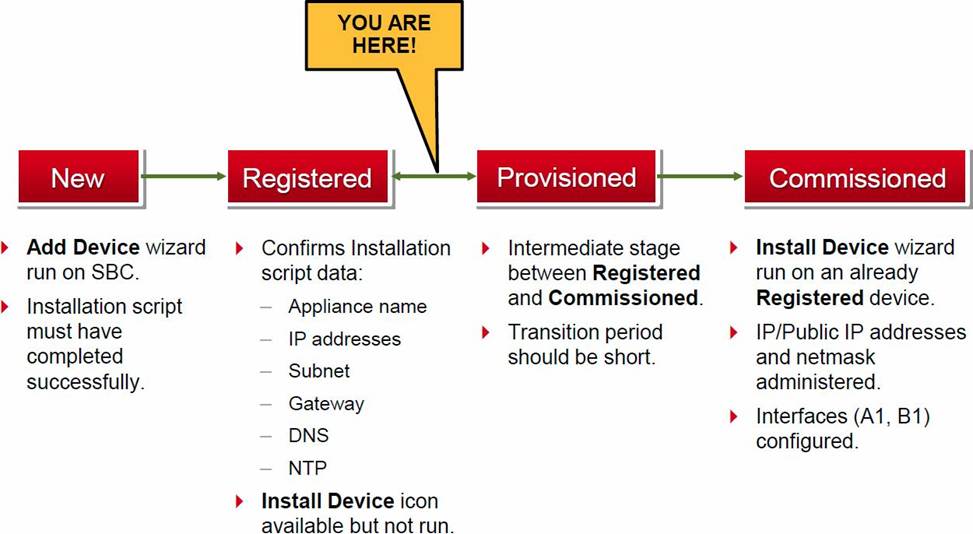Practice Free 71301T Exam Online Questions
You are starting the process to create a server certificate so it can be installed in the Avaya Session Border Controller (SBC).
What must be done before creating a server certificate for SBC?
- A . Generate a Certificate Signing Request (CSR) in SBC.
- B . Run initTM -d from SBC CLI.
- C . Add End Entity in Session Manager.
- D . Download a CA PEM file from System Manager.
The provisioning script automatically runs as part of the first boot-up of the Avaya Session Border Controller for Enterprise (SBCE). During this process you assign the Management IP address to the SBCE. You browse to the Element Management System (EMS) to continue to install the SBCE.
On the System Management > Devices web page, which status does the SBCE display before the Install link is clicked?
- A . Ready
- B . Provisioned
- C . Registered
- D . Commissioned
C
Explanation:

References: Avaya Aura Session Border Controller Enterprise (2012), page 201
The provisioning script automatically runs as part of the first boot-up of the Avaya Session Border Controller for Enterprise (SBCE). During this process you assign the Management IP address to the SBCE. You browse to the Element Management System (EMS) to continue to install the SBCE.
On the System Management > Devices web page, which status does the SBCE display before the Install link is clicked?
- A . Ready
- B . Provisioned
- C . Registered
- D . Commissioned
C
Explanation:

References: Avaya Aura Session Border Controller Enterprise (2012), page 201
In Avaya Session Border Controller for Enterprise (SBCE), what is the default state of an Interface?
- A . Deployed
- B . Enabled
- C . Disabled
- D . Active
C
Explanation:
Example:
Commission the SBC―SBC Configuration
In Avaya Session Border Controller for Enterprise (SBCE), what is the default state of an Interface?
- A . Deployed
- B . Enabled
- C . Disabled
- D . Active
C
Explanation:
Example:
Commission the SBC―SBC Configuration
In Avaya Session Border Controller for Enterprise (SBCE), what is the default state of an Interface?
- A . Deployed
- B . Enabled
- C . Disabled
- D . Active
C
Explanation:
Example:
Commission the SBC―SBC Configuration
In Avaya Session Border Controller for Enterprise (SBCE), what is the default state of an Interface?
- A . Deployed
- B . Enabled
- C . Disabled
- D . Active
C
Explanation:
Example:
Commission the SBC―SBC Configuration
In Avaya Session Border Controller for Enterprise (SBCE), what is the default state of an Interface?
- A . Deployed
- B . Enabled
- C . Disabled
- D . Active
C
Explanation:
Example:
Commission the SBC―SBC Configuration
When planning the Avaya Session Border Controller for Enterprise (SBCE) for SIP Trunking, what is a good practice to adopt?
- A . Name Interfaces consistently, for example, A1 for Internal network to Call Server and B1 for external to Trunk Server.
- B . Name all internal and external interfaces exactly the same.
- C . Use the same IP address on both, internal and external sides of the network.
- D . Use one Avaya Session Border Controller for Enterprise on the internal and external sides of the network.
A
Explanation:
Use the same interface mapping throughout! Examples in this section use:

References: Avaya Aura Session Border Controller Enterprise Implementation and Maintenance (2012), page 304
The media stream in WebRTC is anchored on which Avaya Aura® component?
- A . Avaya Aura® Media Gateway G430/G450
- B . Avaya Aura® Media Server (AAMS)
- C . No DSP Resources are required
- D . G650 Medpro
B
Explanation:
The Avaya WebRTC Snap-in enables users inside or outside the Enterprise to make a secure call from their web browser to any endpoint to which Avaya Aura® can deliver calls.
The WebRTC Snap-in supports 1800 simultaneous calls at a rate of 28,000 BHCC in the following deployment model:
1 Avaya Breeze server
1 Avaya Session Border Controller for Enterprise (Avaya SBCE) server
8 Avaya Aura Media Servers
References: Avaya WebRTC Snap-in Reference, Release 3.1 (May 2016), page 26 https://downloads.avaya.com/css/P8/documents/101013939
